
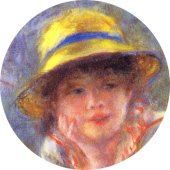


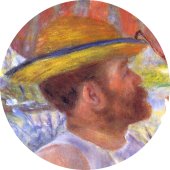


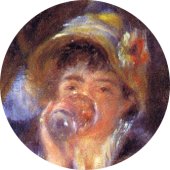


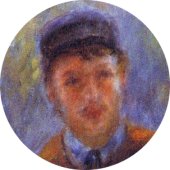


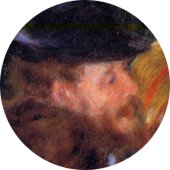


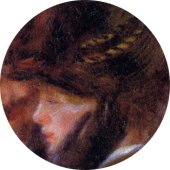




















































Teacher's Guide for
Luncheon of the Boating Party
prepared by Susan Vreeland
This page contains:
Suggested Scenes for Reading Aloud
Topics for Class Discussion
Collaborative Research Topics
Topics of Personal Inquiry
Creative Projects
In-Class Writing Prompts
Essay Topics
Bloom's Taxonomy of Thinking Skills
Bibliography of Useful Sources
You are encouraged to make use of Susan Vreeland's entire website, to download any material you consider useful, and to send any topics or projects you devise to Susan Vreeland for posting on this teacher's guide.
Because emphasis is often placed on having students relate a piece of literature to themselves, to the world as they know it, and to other pieces of literature, topics and activities that fulfill these functions are marked as follows:
T-S -- Text to Self
T-W -- Text to the World
T-T -- Text to Text
Suggested Scenes for Reading Aloud:
1. The opening, p.1-4.
2. Formulation of the subject in Renoir's mind, p. 8-9
3. The argument with Degas in Café Nouvelle-Athènes, p. 40-42
4. Angèle's story of her life, p. 76-77
5. The first painting session, p. 95-99
6. Discussion of the cork, p. 120-121
7. Scene in Charles Ephrussi's study, p. 138-142
8. Ellen's story of the Folies Bergère, p. 188-18
9. Alphonsine's account of the Siege of Paris, p. 203-208
Topics for Class Discussion:
Please note that some of these are suitable for student compositions, as well as for discussion as a class, in pairs, or in small groups. Underlined words are from Bloom's Taxonomy of Thinking Skills. See footnote.
1. State Renoir's credo, that is, his two principles. Cite the source.
2. Given Renoir's financial situation and career, identify what choices of action he had at Madame Charpentier's salon. Assess whether his decision was the best one he could have made. (T-W)
3. Auguste is a complexity of contraries. Is he prideful or humble? Resilient or easily defeated? Insensitive or thoughtful? Loving or unloving? Is he a philanderer? Is he at ease with himself in all circumstances? Identify the conditions or situations that bring out each of these qualities in him.
4. What ambiguities of identity and what ironies do Auguste and Gustave have? What two selves do each of them have? How are they opposites and how are they similar?
5. Make a judgment about the relationship between Alphonsine and Renoir. In what ways did Renoir influence Alphonsine, and vice versa? What do they appreciate in each other? Quote textual references.
6. In what sense is Auguste religious? What applications in his life do you see of his statement to Antonio that "religion is everywhere?"
7. In what ways does the term passion apply to Alphonsine, Auguste, Angèle, Ellen, and Gustave? Identify occasions of passionate acts by each of them. What similarities do you find among them in terms of their values and motivations?
8. Renoir has been criticized for the prettiness and superficiality of his scenes with women, and that he is a shallow painter. Do you agree? Support your position. When Alphonsine asks if he thinks that people are more than color and shape, he answers, "It's not my job to think. It's to feel and to see." Moments later, he says, "I paint women as I'd paint carrots." Interpret that statement. To what extent do you take it as literal truth? Is such an attitude true for all artists in all time periods? (T-W)
9. Examine how participation in this painting as a model influences particular characters. How are they representatives of the late nineteenth century, or exceptions to the social mores of the time? (T-W)
10. Analyze Angèle's moral choice. Give a statement of her principles and an example. Given the time, the situation, and Angèle's character, was her action a good choice? If not, how did she turn it into something good?
11. How does Paul Lhôte live out his toast at the first luncheon? To what extent was he in control of his own fate?
12. What does Auguste see in Aline? What does he appreciate in her? Find passages from scenes with her and from scenes where she isn't present to support your assessment.
13. What is at stake in Alphonsine's conflict to give the hat? What makes her hesitate? In the final chapter, why does she say giving the hat was more difficult than saving the life of an enemy soldier?
14. Examine Durand-Ruel's deal. Evaluate its advantages and disadvantages. Decide whether Renoir should agree to it.
15. When Gustave gives Alphonsine some advice, tell how she follows and/or does not follow this advice.
16. When the models are finished posing for the last time, Jules quotes from the poem, "Fra Lippo Lippi." How does the poem reflect the narrative? The poem's next two lines are: "God uses us to help each other so,/Lending our minds out." Does this change what you've said in answer to the first part of this question?
17. After the last luncheon, Renoir is looking at the five women who modeled for the painting. He says that all of them are brave. Apply this assessment to each one individually. How does this remark relate to his other remark that he paints women as he would paint carrots?
18. What does Renoir gain by painting Luncheon of the Boating Party, in terms of his artistic career and in ways other than his art?
Collaborative Research Topics:
Some of these topics involve research into art history or social history. The results of the research can be presented to the class, or prepared in written form. Other topics are suited to having contributions made by several people.
1. Discover echoes of scenes, that is, repeats of activities or settings. How do these echoes enrich the novel and move forward the plot?
2. Speculate what Auguste, the man with the same history and sensibilities, would be painting if he lived in the eighteenth century. Compared to other eighteenth century styles, what would his style(s) be like? What might his style and subjects be if he lived now?
3. Speculate which artists Renoir might have admired if he could have seen the developments in art history after his time (b.1841, d.1919). Defend your choices by reference to specific works.
4. Renoir's theme of people around a dining table has been frequently used in art history. Consider his own The Inn of Mother Anthony, Marlotte (Paintings and Passages page of Vreeland's website), his End of the Lunch (The Book page of Vreeland's website), his The Rowers' Lunch (Background page of Vreeland's website) as well as Veronese's, Marriage Feast at Cana (Paintings and Passages page on Vreeland's website) van Gogh's, The Potato Eaters (Van Gogh Museum website), Manet's Luncheon on the Grass (Déjeuner sur l'herbe) (Musée d'Orsay website; also on Paintings and Passages for Life Studies on Vreeland's website), Leonardo da Vinci's The Last Supper (in Santa Maria della Grazie, Milan) Le Nain's The Peasant Meal (Louvre website), Jean-Baptiste Siméon Chardin's Grace (Louvre website), François Boucher's The Breakfast (Louvre website), Jean-François de Troy's The Hunt Luncheon (Louvre website), Pieter Brueghel's The Marriage Feast, and Henri Gervex's Café Scene in Paris (Paintings and Passages page on Vreeland's website.)
Draw conclusions as to why this theme of a gathering around a table is appealing to painters? Make a list of the possibilities it affords them.(T-T, considering a painting as a text)
If you were a painter, how would you treat the motif of a midday meal? What occasion or situation, if any, would you be celebrating? In what setting? What would the menu be? How would the lines of interaction cross?(T-S)
5. Identify some paintings by Renoir which reflect specific characteristics of the Impressionist period. (T-W; see glossary on website) Describe them in detail, both subject and style, and speculate about what is going on in each painting, and how it relates to la vie moderne.
6. Select another Impressionist painter referred to in the book and compare his/her life, social class, attitudes, artistic themes, and style to Renoir's. (T-T) Divide the tasks with others doing the same painter and prepare a group presentation with paintings from books as examples. Certain words listed in the glossary (see website) will give you vocabulary to use. Choose from:
Gustave Caillebotte, less of a true Impressionist because of his sharper images, innovative viewpoints, subjects include urban scenes on balconies, the boulevards, rowers, workers, the contrast in social classes.
Mary Cassatt, American Impressionist, considered oh-so-feminine; painted themes of motherhood.
Paul Cézanne, innovator in simplifying shapes of buildings, trees, fruit who did much to usher in modern art; concerned with the structure of things conveyed in strong colors.
Edgar Degas, innovator in composition, often cutting off a figure at the painting's edge; subjects include dancers, cafés, horse races, a master of depicting movement.
Edouard Manet, a forerunner to Impressionism, less sketchy, more solid, urban subjects in cafés, cabarets, boulevards, theaters, the Folies Bergère.
Claude Monet, primarily a landscape painter who loved the Seine as Renoir did, often painted alongside him, and was a master of the detached, contrasting stroke. Subjects were the river, haystacks, Rouen cathedral facade in various lighting, seacoast, and his garden at Giverny.
Berthe Morisot, central to Impressionist movement in terms of leadership, the most sketchy in style, urban or coastal scenes usually with a figure or several.
Camille Pissarro, a true Impressionist and plein air painter using distinctly visible strokes of subjects of rural charm.
Alfred Sisley, an Englishman painting in France, delicate river, rural, and village scenes, softly colored.
Topics of Personal Inquiry:
1. For one week, play the role of a flâneur (see glossary on website; male social observer) or a flâneuse (female social observer) and select one, two, or three items which you consider representative of this time period. Record your observations in detail, choosing words that both describe precisely and reveal your attitude toward the thing observed. End with a comment on how this observation reflects modernity as you see it. (T-W)
2. Of all Renoir's or Caillebotte's paintings, identify one (or more than one) which speak/speaks to you most strongly. (T-S) Do one or several of the following:
Write a description of it/them covering subject and style, providing the reasons it/they appeal(s) to you. (T-S)
b. Write a hypothetical letter to a figure in this painting bringing the figure up to date about a topic you think he/she would be interested in. (T-W)
c. Write a letter from this person to a close friend of this person. Have it concern the moment portrayed, as well as reveal something about the recipient. Rewrite the letter to reveal something of yourself, as though you in a different time period were the person receiving the letter. Compare both versions.
Creative Projects:
1. Use a painting by Renoir (other than Luncheon of the Boating Party), Caillebotte, Degas, Monet, or Manet to spark a poem. Start by slowly surveying the paintings in the Paintings and Passages section of www.svreeland.com, but also consult the Bibliography and peruse some of the art books listed. You might narrate the meaning of a scene the way the painter imagined it, write it from the point of view of the figure in the painting, or just respond to it from your own well of experience to the shapes, colors, setting, and the feel of the subject. (T-S, considering the painting as a text) You might choose to address one of the questions below, but don't feel you need to write a direct answer to the question in your poem. Just let one of the following questions (or one you pose, T-S) together with an image suggest a line of thinking, and follow it.
What thoughts were swirling around in the women's minds in Degas' Women on a Café Terrace?
What are the joys of rowing as depicted by Caillebotte?
What political message is suggested by Manet's The Rue Mosnier Decorated with Flags? (T-W)
What is about to happen in Renoir's Oarsmen at Chatou?
2. Write the song the performer is singing in Degas' The Glove. (See the Book page on website.)
3. From the point of view of the woman or the man in Renoir's The Loge, write a diary entry of the evening. (See Background page website.)
4. If you were to paint a self-portrait, how would you portray yourself? With what qualities? Doing what act? Dressed in what colors? Associated with what historical time period? (T-S) Create the portrait in words.
5. Reread the scene in Chapter Three between Renoir and Degas. Then rewrite the scene in Chapter Thirty-nine when Fournaise shows the painting to the crowd, but with Degas present.
6. Of the fourteen models, seven have chapters from their points of view. Select one who doesn't have a chapter and write one, making it like a story of its own, with conflict, one additional character of your invention, and an impact on or relationship to the painting.
7. What if there had been a scene with dialogue between Alphonsine and Aline occurring sometime after Chapter Thirty-one, "Not One Canotier Song?" Create it. Select one of the women as your point-of-view character and suggest her reactions to and feelings about the other woman. Distinguish between the way each one would speak. What subjects would they discuss? What would be the tone of the interaction? What would be left unsaid? Try to make that evident to the reader through gesture, hesitation, body language, looks, trailed-off sentences.
8. Create the unshown scene between Alphonse and Ellen when he takes her out in a boat in Chapter Thirteen. Choose one as your point-of-view character and suggest his/her reactions to and feelings about the other person. What subjects would they discuss? What will be left unsaid? Try to make that evident to the reader through gesture, hesitation, body language, looks, trailed-off sentences.
9. Compose a poem that Jules would write about the experience of being a model in Luncheon of the Boating Party.
10. Spend at least five minutes thinking about this quote by Robert Hillyer from The Pursuit of Poetry: "The poetic temperament is the faculty which perceives the most ordinary events of life as something wonderful and interesting, the most ordinary objects of life as something beautiful or significant. Without for a moment losing sight of that existence which he shared with his kind, the poet will at the same time, observe it with a greater excitement than others and from a larger perspective." Now write a Symbolist poem using the formula x = y = z, as explained in Chapter Seventeen.
In-Class Writing Prompts:
Formulate a definition of la vie moderne. Students volunteer to read theirs aloud. Draw a conclusion about how the class (or your group within the class) thinks. Compare your definition to other students' definitions. Which one comes closest to agreement with your own? What other student's definition do you like which is different from your own?
Compose a statement about what great art is supposed to do. Read them aloud. Draw a conclusion about how your group thinks, and present it to the rest of the class. Defend your statement.
Essay Topics:
Many of the discussion questions in the early section of this guide are suitably complex for an essay topic. Here are some more.
1. Examine the theme of the longing for expression as revealed in four characters. How does Jules' quoting Shakespeare reflect this longing? What does the novel suggest about this human longing?
3. Identify three aspects of late nineteenth century Paris that the novel illuminated. Cite textual sources for each, and explain how they impacted the characters' lives.
4. Recognize the figurative language and repeated motifs which make the novel cohesive. Examine the concrete images that appear more than once, perhaps with variation or from different characters. (For example, look for instances in which a bridge figures either literally or metaphorically. In what ways is this painting a bridge? What other concrete things function similarly?) How does the author get them to resonate with more meaning as they reappear and as the novel progresses?
5. Write an analysis (a close textual study) of three scenes relating to the Franco-Prussian War. What knowledge about it is conveyed? Identify words and phrases with connotations, characters' motives and attitudes, and from these, assess the author's sensibility.
6. Select a sentence from the quotes by Renoir on this website, or from the quotes that follow, and analyze how it applies to the novel. Quote short passages in the novel which illustrate the selected quote.
Quotes to consider:
If I were called on to define briefly the word 'art,' I should call it the reproduction of what the senses perceive in nature, seen through the veil of the soul.
Paul Cézanne, Letters, ed. by John Rewald, 1984.
Works of art are indeed always products of having been in danger, of having gone to the very end in an experience, to where man can go no further.
Erich Maria Rilke, Letters
Art is a human activity whose purpose is the transmission of the highest and best feelings to which men have attained.
Leo Tolstoy, What is Art?
The present task of art is to make the feeling of brotherhood and love of one's neighbor, which is now shared only by the best members of society, the customary feeling, even the instinct, of all human beings.
Leo Tolstoy, What is Art?
What is art/But life on a larger scale.
Elizabeth Barrett Browning
Every artist dips his brush in his own soul, and paints his own nature into his pictures.
Henry Ward Beecher
It is the treating of the commonplace with the feeling of the sublime that gives to art its true power.
Jean-Francois Millet, personal notes (1838-1875)
Art is like a footprint which shows one has walked bravely and in great happiness.
Robert Henri, The Art Spirit, 1923
Art, if it is to be reckoned as one of the great values of life, must teach men humility, tolerance, wisdom and magnanimity. The value of art is not beauty, but right action.
W. Somerset Maugham, A Writer's Notebook (1949)
For an artist to be interesting to us he must have been interesting to himself. He must have been capable of intense feeling and capable of profound contemplation. He who has contemplated has met with himself, is in a state to see into the realities beyond surfaces of his subjects.
Robert Henri, The Art Spirit
To draw, you must close your eyes and sing.
Pablo Picasso, statement made on NBC-TV, Sept 15, 1957
And in a picture, I want to say something comforting, as music is comforting. I want to paint men and women with that something of the eternal which the halo used to symbolize, and which we seek to convey by the actual radiance and vibration of our coloring.
Vincent van Gogh, letter to Theo in Van Gogh's Diary: The Artist's Life in His Own Words and Art, by Jan Hulsker, 1971.
Intellectual passion drives out sensuality.
Leonardo da Vinci, Treatise on Painting, 1651
An artist should paint as if in the presence of God.
Michelangelo, in Michelangelo's Theory of Art, by Robert C. Clements
Everything in art must spring from the movement of our whole life stream, of our whole being--including the unconscious.
Marc Chagall, lecture, "The Artist," 1947
Talent is only one side, perhaps the easier side, of self-development. The other side is self-knowledge.
John W. Gardner, Self-Renewal
The invariable mark of wisdom is to see the miraculous in the common.
Ralph Waldo Emerson, "Prospects," from Nature, Addresses and Lectures, 1849.
______________
* Since Bloom's Taxonomy ranking thinking skills often informs curriculum, those directives of the taxonomy used in this guide are underlined. Skills from the following categories are involved in the question cues and activities:
Level 1: Knowledge (recall of information): tell, list, define, describe, identify, show, examine, quote, name
Level 2: Comprehension (understanding meanings): summarize, describe, interpret, contrast, predict, speculate, associate, distinguish, extend
Level 3: Application (using what has been learned): apply, demonstrate, illustrate, examine, relate, discover
Level 4: Analysis (recognition of nuances of meaning): analyze, explain, compare, select, interpret
Level 5: Synthesis (draw conclusions and create new ideas): design, create, invent, what if?, compose, formulate
Level 6: Evaluation (assessing value and making choices): make choices, assess, support, defend, convince, conclude, compare, judge
Bibliography of Useful Sources:
Crepaldi, Gabriele. The Impressionists. New York: Barnes and Noble, 2002.
Daulte, Francois. Renoir. The Great Impressionists Series. Garden City, NY: Doubleday, 1973.
Distel, Anne, Douglas Druick, et al. Gustave Caillebotte: Urban Impressionist. Musée d'Orsay and Art Institute of Chicago, Abbeville Press, 1995.
Hanson, Lawrence. Renoir: The Man, the Painter, and His World. New York: Dodd, Mead & Co., 1968.
Herbert, Robert. Impressionism: Art, Leisure, and Parisian Society. New Haven: Yale, 1988.
House, John, with Anne Distel and Lawrence Gowing. Renoir. New York: Abrams, 1985.
Néret, Gilles. Renoir: Painter of Happiness. New York: Taschen, 2001.
Rathbone, Eliza et. al. Impressionists on the Seine: A Celebration of Renoir's Luncheon of the Boating Party. Washington, D.C.: Counterpoint in association with The Phillips Collection, 1996.
Varnedoe, Kirk. Gustave Caillebotte. New Haven: Yale, 2000.
susan@svreeland.com